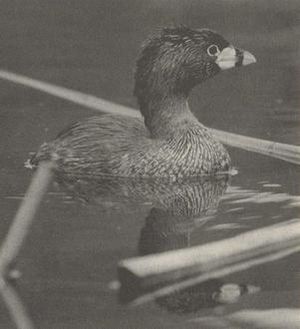Atitlán grebe facts for kids
Quick facts for kids Atitlán grebe |
|
|---|---|
 |
|
| Photo by David G. Allen | |
| Conservation status | |
| Scientific classification | |
| Genus: |
Podilymbus
|
| Species: |
gigas
|
The Atitlán grebe (Podilymbus gigas), also known as the giant grebe or poc, was a special water bird. It was a relative of the pied-billed grebe. This bird lived only in Guatemala, specifically in Lago de Atitlán. This lake is high up in the mountains, about 1,700 meters (5,577 feet) above sea level. Scientists first described it in 1929. Sadly, the Atitlán grebe is now extinct, meaning there are no more left in the world. It was officially declared extinct by 1990.
Contents
What Did the Atitlán Grebe Look Like?
The Atitlán grebe was a fairly large bird. It grew to about 46 to 50 centimeters (18 to 20 inches) long. Its sounds and looks were similar to the smaller pied-billed grebe.
Its bill was large and had a pied (two-colored) look. The color of its bill changed with the seasons. It was white in spring and brown at other times. A bold black band crossed the middle of its bill. Its eyes were brown.
The bird's feathers were mostly dark brown. Its sides had white flecks, and its ears were grey. The feathers on its belly were dark grey with white flecks. Its head was almost black. The neck feathers were shiny and flecked with dark brown in spring. In winter, they were white. Its legs were a slaty grey color. The Atitlán grebe had small wings and could not fly.
How Did They Raise Their Young?
Atitlán grebes laid clutches of 4 to 5 white eggs. Both the mother and father grebe worked together. They shared the job of raising their young chicks.
Why Did the Atitlán Grebe Disappear?
The number of Atitlán grebes started to drop in 1958. This happened again in 1960. The problem began when new fish were put into Lake Atitlán. These fish were smallmouth bass and largemouth bass. They were invasive species, meaning they were not naturally from the lake.
These new fish caused two big problems:
- They ate the crabs and fish that the grebes needed for food.
- They also killed the young grebe chicks.
Because of this, the number of Atitlán grebes fell sharply. In 1960, there were about 200 birds. By 1965, only 80 were left.
An American scientist named Anne LaBastille worked hard to save them. Thanks to her efforts, a special safe area was created in 1966. In this refuge, the grebe population started to grow again. By 1973, their numbers had recovered to 210 birds.
However, another disaster struck in 1976. A big earthquake hit Guatemala. This earthquake cracked the bottom of the lake. Water began to drain out through an underwater hole. The lake's water level dropped a lot. This caused the grebe population to decrease severely once more.
By 1983, only 32 Atitlán grebes remained. Most of these were mixed-breed birds, meaning they had mated with pied-billed grebes. The very last two Atitlán grebes were seen in 1989. After they disappeared, the Atitlán grebe was officially declared extinct.
See also
 In Spanish: Pato poc para niños
In Spanish: Pato poc para niños
- Alaotra grebe, probably extinct since the late 1980s for analogous reasons.
- Colombian grebe


